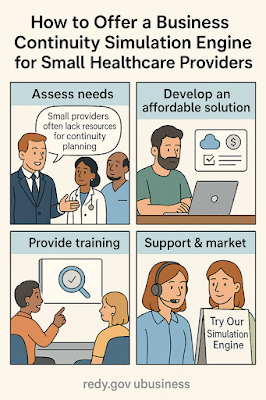How to Offer a Business Continuity Simulation Engine for Small Healthcare Providers
How to Offer a Business Continuity Simulation Engine for Small Healthcare Providers
Ensuring business continuity is essential for healthcare providers, especially small clinics and practices that often lack robust contingency plans.
In this guide, we’ll explore how to design and offer a Business Continuity Simulation Engine specifically for small healthcare providers, making it accessible, affordable, and effective.
Table of Contents
- Why Business Continuity Is Critical for Small Healthcare Providers
- Core Features Your Simulation Engine Must Have
- How to Design an Affordable Solution
- Integration and User Training
- Marketing and Support Strategies
Why Business Continuity Is Critical for Small Healthcare Providers
Small healthcare providers often operate with limited resources, making them particularly vulnerable to disruptions like natural disasters, cyberattacks, or public health emergencies.
Without a solid business continuity plan, a minor incident can lead to prolonged downtime, loss of patient data, or even permanent closure.
By offering a simulation engine, you empower these providers to rehearse emergency responses and refine their continuity plans before a real crisis hits.
Core Features Your Simulation Engine Must Have
A high-quality Business Continuity Simulation Engine should offer:
Scenario Building: Allow users to simulate various types of disruptions (e.g., power outage, ransomware attack, pandemic outbreak).
Risk Assessment: Help evaluate vulnerabilities in the organization’s operations, IT infrastructure, and staff readiness.
Recovery Workflow Simulation: Guide users through step-by-step recovery actions and test the effectiveness of current plans.
Compliance Support: Ensure that scenarios align with healthcare regulations like HIPAA and HITECH.
Reporting & Analytics: Provide detailed reports post-simulation to highlight strengths and areas for improvement.
How to Design an Affordable Solution
Affordability is key for small providers.
Consider offering your simulation engine as a cloud-based SaaS model with tiered pricing.
Basic plans can cover essential simulations, while premium plans offer advanced analytics, compliance certification readiness, and personalized consulting.
Another cost-saving strategy is offering open-source integration options, allowing clinics to connect your simulation tool to their existing EHR systems or data backups without expensive customization.
Integration and User Training
Small healthcare providers often lack dedicated IT teams, so easy integration is crucial.
Offer simple APIs or no-code integration options with major electronic health record (EHR) platforms.
For user training, consider hosting webinars, creating short instructional videos, and offering an online certification after simulation exercises.
This approach builds trust and ensures better adoption of your product.
Marketing and Support Strategies
Marketing to small healthcare providers requires a tailored approach.
Focus your messaging on risk reduction, regulatory compliance, and business resilience.
Attend healthcare trade shows, offer free trials, and partner with medical associations to reach your target audience effectively.
Finally, ensure your support is strong and responsive.
Small providers will appreciate live chat support, quick onboarding assistance, and clear documentation.
External Resources
Visit Ready.gov Business Continuity Resources
Learn About HHS Healthcare Cybersecurity Support
Explore NIST Disaster Resilience Resources
Conclusion
Offering a Business Continuity Simulation Engine for small healthcare providers isn't just a business opportunity — it's a chance to make a real difference in community healthcare resilience.
By focusing on affordability, ease of use, compliance, and education, you can provide a critical service that protects both patient care and business viability in uncertain times.
Start by designing a lightweight, intuitive platform, and partner with healthcare associations to maximize your reach and credibility.
Success in this field means stronger, safer communities — and a stronger, safer future for healthcare itself.
Keywords: Business Continuity Simulation, Healthcare Business Continuity, Small Healthcare Providers, Disaster Recovery Healthcare, Healthcare Simulation Software
